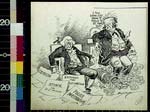1920 – John J. Leary Jr. of the New York World wins a Pulitzer Prize for his coverage of the coal strike a year earlier.
1921 – Barron's is started as a sister publication to The Wall Street Journal
1923 – W.M. Kiplinger publishes the first issue of Kiplinger’s Washington Letter.

Market Crash in 1929
1928 – Clarence Barron dies. A year later, the Wall Street Journal starts a West Coast edition.
October 1929 – Stock market crash sends country into a Depression. Many business publications downplayed the severity of the market’s drop.